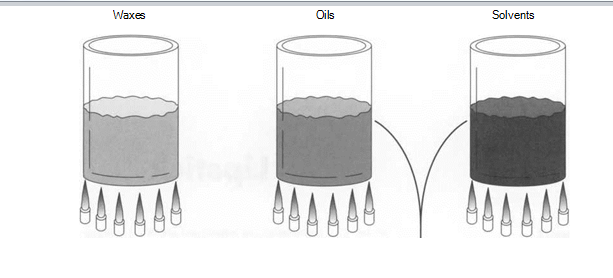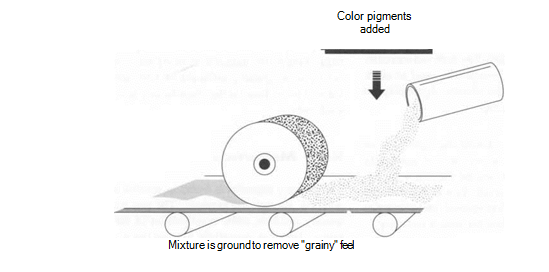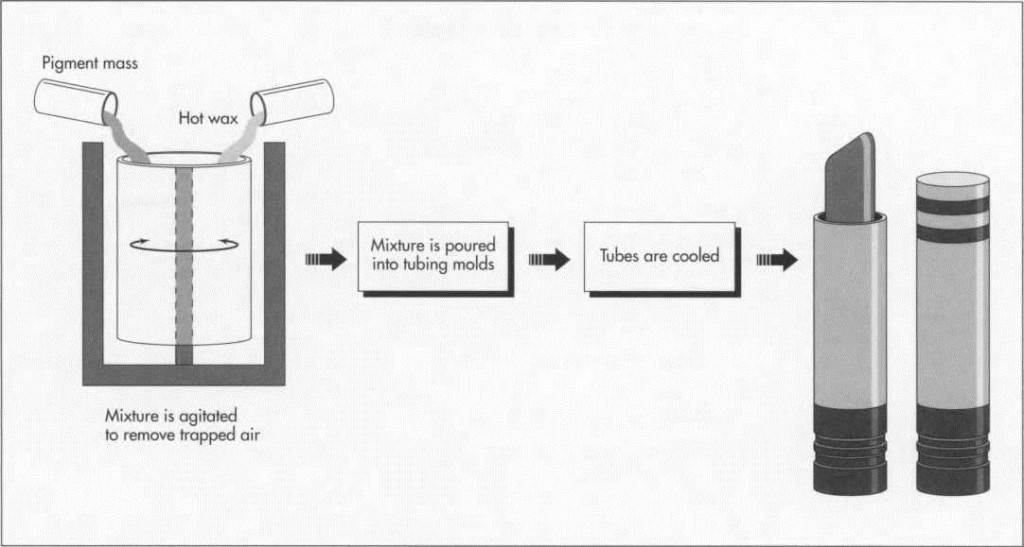
Background
Cosmetics can be traced back to ancient civilizations. In particular, the use of lip color was prevalent among the Sumerians, Egyptians, Syrians, Babylonians, Persians, and Greeks. Later, Elizabeth I and the ladies of her court colored their lips with red mercuric sulfide. For years, rouge was used to color both the lips and the cheeks, depending on the fashion of the times.
In Western society during the latter half of the nineteenth century, it was generally believed only promiscuous women wore lipstick—or makeup at all. It was not until the twentieth century that lipstick, and cosmetics in general, gained true societal acceptance.
Improvements in the manufacture of applicators and metal tubes reduced the cost of the cosmetic. This combined with newfound acceptance by the general population caused widespread use and popularity to increase. By 1915 push up tubes were available, and the first claims of “indelibility” were made.
Lipsticks are made to appeal to the current fashion trend and come in a wide range of colors. Lipstick is made of dyes and pigments in a fragranced oil-wax base. Retail prices for lipsticks are relatively low, with quality products priced at less than $4.00. More expensive products are available, with prices ranging up to nearly $50.00 for exclusive products. Lip balms, by contrast, generally retail for less than $1.00.
The tubes that hold lipstick range from inexpensive plastic dispensers for lip balms to ornate metal for lipsticks. Sizes are not uniform, but generally lipstick is sold in a tube 3 inches (7.6 centimeters) in length and about .50 inch (1.3 centimeters) in diameter. (Lip balms are generally slightly smaller in both length and diameter.) The tube has two parts, a cover and a base. The base is made up of two components, the twisting or sliding of which will push the lipstick up for application. Since the manufacture of the tube involves completely different technologies, we will focus here on the manufacture of lipstick only.
Raw Materials
The primary ingredients found in lipstick are wax, oil, alcohol, and pigment. The wax used usually involves some combination of three types—beeswax, candelilla wax, or the more expensive carnauba. Wax enables the mixture to be formed into the easily recognized shape of the cosmetic. Oils such as mineral, caster, lanolin, or vegetable are added to the wax. Fragrance and pigment are also added, as are preservatives and antioxidants, which prevent lipstick from becoming rancid. And while every lipstick contains these components, a wide variety of other ingredients can also be included to make the substance smoother or glossy or to moisten the lips.
Just as there is no standard to the lipstick size and container shape, there are no standard types of, or proportions for, ingredients used. Beyond the base ingredients (wax, oil, and antioxidants) supplemental material amounts vary greatly. The ingredients themselves range from complex organic compounds to entirely natural ingredients, the proportions of which determine the characteristics of the lipstick. Selecting lipsticks is, as with all cosmetics, an individual choice, so manufacturers have responded by making a wide variety of lipsticks available to the consumer.
In general, wax and oil make up about 60 percent of the lipstick (by weight), with alcohol and pigment accounting for another 25 percent (by weight). Fragrance is always added to lipstick, but accounts for one percent or less of the mixture. In addition to using lipstick to color the lips, there are also lip liners and pencils. The manufacturing methods described here will just focus on lipstick and lip balms.
(To make lipstick, the various raw ingredients are first melted separately, and then the oils and solvents are ground together with the desired color pigments.)
The Manufacturing Process
The manufacturing process is easiest to understand if it is viewed as three separate steps: melting and mixing the lipstick; pouring the mixture into the tube; and packaging the product for sale. Since the lipstick mass can be mixed and stored for later use, mixing does not have to happen at the same time as pouring. Once the lipstick is in the tube, packaging for retail sale is highly variable, depending on how the product is to be marketed.
Melting and mixing
1 First, the raw ingredients for the lipstick are melted and mixed—separately because of the different types of ingredients used. One mixture contains the solvents, a second contains the oils, and a third contains the fats and waxy materials. These are heated in separate stainless steel or ceramic containers.
2 The solvent solution and liquid oils are then mixed with the color pigments. The mixture passes through a roller mill, grinding the pigment to avoid a “grainy” feel to the lipstick. This process introduces air into the oil and pigment mixture, so mechanical working of the mixture is required. The mixture is stirred for several hours; at this point some producers use vacuum equipment to withdraw the air.
(After the pigment mass is prepared, it is mixed with the hot wax. The mixture is agitated to free it of any air bubbles. Next, the mixture is poured into tubing molds, cooled, and separated from the molds. After final touch-up and visual inspection, the lipstick is ready for packaging.)
After the pigment mass is ground and mixed, it is added to the hot wax mass until a uniform color and consistency is obtained. The fluid lipstick can then be strained and molded, or it may be poured into pans and stored for future molding.
4 If the fluid lipstick is to be used immediately, the melt is maintained at temperature, with agitation, so that trapped air escapes. If the lipstick mass is stored, before it is used it must be reheated, checked for color consistency, and adjusted to specifications, then maintained at the melt temperature (with agitation) until it can be poured.
As expected, lipsticks are always prepared in batches because of the different color pigments that can be used. The size of the batch, and the number of tubes of lipstick produced at one time, will depend on the popularity of the particular shade being produced. This will determine the manufacturing technique (automated or manual) that is used. Lipstick may be produced in highly automated processes, at rates of up to 2,400 tubes an hour, or in essentially manual operations, at rates around 150 tubes per hour. The steps in the process basically differ only in the volume produced.
Molding
5 Once the lipstick mass is mixed and free of air, it is ready to be poured into the tube. A variety of machine setups are used, depending on the equipment that the manufacturer has, but high volume batches are generally run through a melter that agitates the lipstick mass and maintains it as a liquid. For smaller, manually run batches, the mass is maintained at the desired mix temperature, with agitation, in a melter controlled by an operator.
6 The melted mass is dispensed into a mold, which consists of the bottom portion of the metal or plastic tube and a shaping portion that fits snugly with the tube. Lipstick is poured “up-side down” so that the bottom of the tube is at the top of the mold. Any excess is scraped from the mold.
7 The lipstick is cooled (automated molds are kept cold; manually produced molds are transferred to a refrigeration unit) and separated from the mold, and the bottom of the tube is sealed. The lipstick then passes through a flaming cabinet (or is flamed by hand) to seal pinholes and improve the finish. The lipstick is visually inspected for air holes, mold separation lines, or blemishes, and is reworked if necessary.
8 For obvious reasons, rework of the lipstick must be limited, demonstrating the importance of the early steps in removing air from the lipstick mass. Lipstick is reworked by hand with a spatula. This can be done inline, or the tube can be removed from the manufacturing process and reworked.
Labeling and packaging
9 After the lipstick is retracted and the tube is capped, the lipstick is ready for labeling and packaging. Labels identify the batch and are applied as part of the automated operation. While there is a great deal of emphasis on quality and appearance of the finished lipstick product, less emphasis is placed on the appearance of lip balms. Lip balms are always produced in an automated process (except for experimental or test batches). The heated liquid is poured into the tube in the retracted position; the tube is then capped by machine—a far less laborious process.
The final step in the manufacturing process is the packaging of the lipstick tube. There are a variety of packaging options available, ranging from bulk packs to individual packs, and including packaging as a component in a makeup kit or special promotional offering. Lip balms are packaged in bulk, generally with minimum protection to prevent shipping damage. Packaging for lipsticks varies, depending on what will happen at the point of sale in the retail outlet. Packaging may or may not be highly automated, and the package used depends on the end use of the product rather than on the manufacturing process.
Byproducts
There is little or no waste in the manufacture of lipstick. Product is reused whenever possible, and since the ingredients are expensive they are seldom thrown out, unless no other alternative presents itself. In the normal manufacturing process there are no byproducts, and waste portions of lipstick will be thrown out with the disposal of cleaning materials.
Quality Control
Quality control procedures are strict, since the product must meet Food and Drug Administration (FDA) standards. Lipstick is the only cosmetic ingested, and because of this strict controls on ingredients, as well as the manufacturing processes, are imposed. Lipstick is mixed and processed in a controlled environment so it will be free of contamination. Incoming material is tested to ensure that it meets required specifications. Samples of every batch produced are saved and stored at room temperature for the life of the product (and often beyond that) to maintain a control on the batch.
As noted above, appearance of lipstick as a final product is very important. For this reason everyone involved in the manufacture becomes an inspector, and non-standard product is either reworked or scrapped. Final inspection of every tube is performed by the consumer, and if not satisfactory, will be rejected at the retail level. Since the retailer and manufacturer are often times not the same, quality problems at the consumer level have a major impact on the manufacturer.
Color control of lipstick is critical, and one only has to see the range of colors available from a manufacturer to be aware of this. The dispersion of the pigment is checked stringently when a new batch is manufactured, and the color must be carefully controlled when the lipstick mass is reheated. The color of the lipstick mass will bleed over time, and each time a batch is reheated, the color may be altered. Colorimetric equipment is used to provide some numerical way to control the shades of lipstick. This equipment gives a numerical reading of the shade, when mixed, so it can identically match previous batches. Matching of reheated batches is done visually, so careful time and environment controls are placed on lipstick mass when it is not immediately used.
There are two special tests for lipstick: the Heat Test and the Rupture Test. In the Heat Test, the lipstick is placed in the extended position in a holder and left in a constant temperature oven of over 130 degrees Fahrenheit (54 degrees Celsius) for 24 hours. There should be no drooping or distortion of the lipstick. In the Rupture Test, the lipstick is placed in two holders, in the extended position. Weight is added to the holder on the lipstick portion at 30-second intervals until the lipstick ruptures. The pressure required to rupture the lipstick is then checked against the manufacturer’s standards. Since there are no industry standards for these tests, each manufacturer sets its own parameters.
The Future
Lipstick is the least expensive and most popular cosmetic in the world today. In 1986 lipstick sales in the United States were more than $720,000,000. There are no accurate figures for current sales of lip balm, since the market is expanding. Manufacturers continue to introduce new types and shades of lipstick, and there is a tremendous variety of product available at moderate cost. As long as cosmetics remain in fashion (and there is no indication that they will not) the market for lipstick will continue to be strong, adding markets in other countries as well as diversifying currently identified markets.
Where To Learn More
Books
Brumber, Elaine. Save Your Money, Save Your Face. Facts on File Publications, 1986.
Donsky, Howard. Beauty Is Skin Deep. Rodale Press, 1985.
Schoen, Linda Allen, ed. The AMA Book of Skin and Hair Care. J.B. Lippincott Company, 1976












